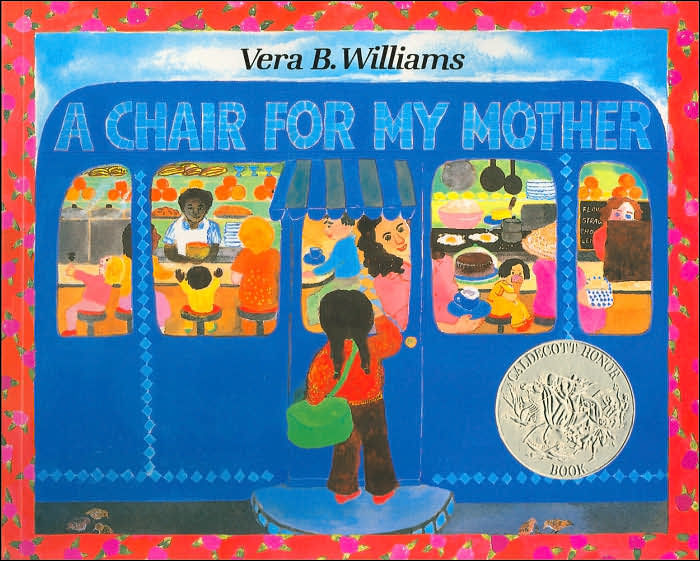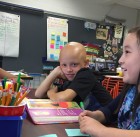Viewing: A Chair for My Mother
October 22, 2017
What are we reading?
Hello, families! I apologize for the long stretch since I’ve gotten to touch base with you. I try to post an update every few weeks, but it seems like things at PGS are getting busier and busier. Please know that if you’re not hearing from me for a while, it’s not a lack of interest or concern, but rather, I’m trying to tackle things that are time sensitive. Planning instruction, reviewing student work, emailing or calling families, and meeting with coworkers are all things that can push website posts to the back burner. But I will do my very best to keep on top of this as well.
 On to the updates! In reading, we have been focusing on narrative elements, which are the parts of a story. Sound repetitive? Your fourth grader has probably learned this every year since kindergarten! But each year, we get a bit more in-depth. Narrative elements are: setting, characters, problems, solutions, and main events. With this focus, we also learn about theme, summaries, and retellings. We started with a study of character traits, and this past week, we really immersed ourselves in a study of setting. Hopefully your child asked you about setting last week, because while many of us adults correctly identify setting as WHERE the story takes place, we often forget that setting is also WHEN a story takes place. To focus on character and setting, we’ve read four wonderful books: The Purple Coat is a great book about a girl who desperately wants a purple coat, instead of her usual navy coat. This was one of my most beloved books when I was young, and I’m glad to share it with the students! (I told the kids that this was my absolute favorite book, but I’ve already said that about a few different titles, so I think they’re on to me.) We searched for evidence in the text to find where and when the story took place, and we used color-coded highlighting tape to organize the evidence. In fourth grade, a big focus is not just finding textual evidence (also often referred to as textual support) to prove one’s point of view, but in choosing the most valuable examples to highlight one’s argument. In the case of The Purple Coat, there was ample evidence to show when and where the story took place, so we were able to work on how to be selective.
On to the updates! In reading, we have been focusing on narrative elements, which are the parts of a story. Sound repetitive? Your fourth grader has probably learned this every year since kindergarten! But each year, we get a bit more in-depth. Narrative elements are: setting, characters, problems, solutions, and main events. With this focus, we also learn about theme, summaries, and retellings. We started with a study of character traits, and this past week, we really immersed ourselves in a study of setting. Hopefully your child asked you about setting last week, because while many of us adults correctly identify setting as WHERE the story takes place, we often forget that setting is also WHEN a story takes place. To focus on character and setting, we’ve read four wonderful books: The Purple Coat is a great book about a girl who desperately wants a purple coat, instead of her usual navy coat. This was one of my most beloved books when I was young, and I’m glad to share it with the students! (I told the kids that this was my absolute favorite book, but I’ve already said that about a few different titles, so I think they’re on to me.) We searched for evidence in the text to find where and when the story took place, and we used color-coded highlighting tape to organize the evidence. In fourth grade, a big focus is not just finding textual evidence (also often referred to as textual support) to prove one’s point of view, but in choosing the most valuable examples to highlight one’s argument. In the case of The Purple Coat, there was ample evidence to show when and where the story took place, so we were able to work on how to be selective. 
We have also read Melissa Parkington’s Beautiful, Beautiful Hair, which, while not on my list of favorite books, is an outstanding story about a girl who wants to be known for something she does, not just for her lovely hair. This was a great means for us to focus on character traits, and as we learned more about Melissa Parkington, we were able to identify and support our opinions about her character traits.
 You may have seen The Josefina Story Quilt come home a few weeks ago. It’s a bit basic for most fourth graders, but that allows us to focus on interpreting the story, rather than on decoding hard works and understanding the language in the text. It’s a great story about the trials and tribulations of a family traveling west to California in a covered wagon. This text has it all, and students have been working with partnerships to practice writing short answer responses about the various narrative elements. We review these responses as a class so they can see first-hand examples of what a strong response “looks like” and so they can have more practice with writing a clear, well supported response to text.
You may have seen The Josefina Story Quilt come home a few weeks ago. It’s a bit basic for most fourth graders, but that allows us to focus on interpreting the story, rather than on decoding hard works and understanding the language in the text. It’s a great story about the trials and tribulations of a family traveling west to California in a covered wagon. This text has it all, and students have been working with partnerships to practice writing short answer responses about the various narrative elements. We review these responses as a class so they can see first-hand examples of what a strong response “looks like” and so they can have more practice with writing a clear, well supported response to text.
 Finally, students have independently read A Chair for My Mother. This book definitely falls on my favorite books list, and it might fall pretty close to the top. It’s about a girl whose family has to rebuild their life after their home burns down in a fire. It may sound unsettling from my quick summary, but it is a genuinely heartwarming text. (Another favorite from my childhood. Who reading this was a Reading Rainbow child growing up? Butterfly in the sky…) This is our “assessment” text, meaning that students are writing their own short-answer responses about the narrative elements in this text. I’ve given you a link to the book above, but as I’m using this as an assessment tool, I appreciate your willingness to let your students work through the story themselves, without benefitting from your expert interpretation of the text. I’ll let you know once we’re done using this text (probably close to conferences), and you’ll be free to enjoy it as a family (though I fear that your fourth grader might be tired of it by then).
Finally, students have independently read A Chair for My Mother. This book definitely falls on my favorite books list, and it might fall pretty close to the top. It’s about a girl whose family has to rebuild their life after their home burns down in a fire. It may sound unsettling from my quick summary, but it is a genuinely heartwarming text. (Another favorite from my childhood. Who reading this was a Reading Rainbow child growing up? Butterfly in the sky…) This is our “assessment” text, meaning that students are writing their own short-answer responses about the narrative elements in this text. I’ve given you a link to the book above, but as I’m using this as an assessment tool, I appreciate your willingness to let your students work through the story themselves, without benefitting from your expert interpretation of the text. I’ll let you know once we’re done using this text (probably close to conferences), and you’ll be free to enjoy it as a family (though I fear that your fourth grader might be tired of it by then).
Coming soon: Updates on math, science, social studies, and targeted instruction!
Posted in Class Updates|By Jon Moss
October 4, 2015

Learning to Collaborate
A big focus in Room 209 in learning to collaborate on tasks and explain your thinking. People often think that collaboration helps during challenging activities, and that’s certainly true. But we also have students collaborate even when they could easily complete a task independently, because the process of sharing ideas, considering other points of view, and discussing strategies and options helps students to think more deeply about a given topic. It also helps to develop collaboration skills that are, of course, critical life skills.
Last week, for example, we began working on narrative elements by focusing on the setting of stories. We read, as a class, The Purple Coat (one of my all-time favorites) and identified clues about the setting. I then modeled the process of writing a short-answer response (SAR) to identify and explain the setting of the story. We looked at the SAR Checklist as a way of remembering the elements of a successful short-answer response. Students then collaborated with one or two partners to write a similar response about The Josefina Story Quilt, which students read for homework on Monday or Tuesday. We shared some of these responses (from groups that volunteered) and discussed strengths and weaknesses, using the new fourth grade SAR rubric. (Stay tuned for some resources for parents!) On Friday, students worked independently to write their own SAR about the setting of A Chair for My Mother (which is arguably my all-time favorite children’s book). This process of gradual release supports students as we move from teacher-led learning to group work to independent application. You’ll see a lot of this style of learning this year, especially in the next few weeks as we address the remaining narrative elements.
Posted in Class Updates|By Jon Moss
